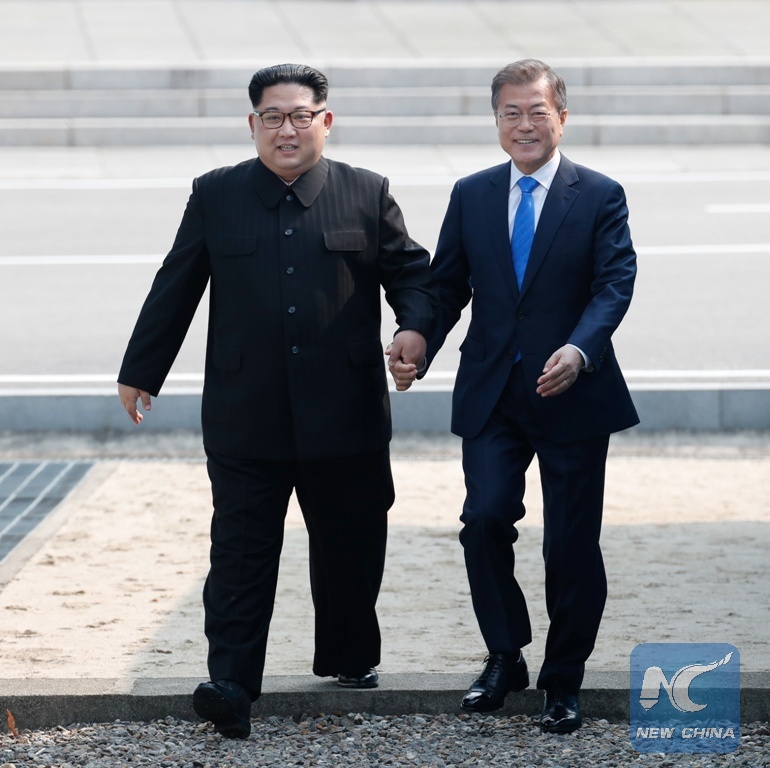
Photo Credit: Xinhua
After a year of rising tensions and concerns over the prospect of conflict over North Korea’s nuclear program, tensions on the Korean Peninsula have momentarily eased. On April 27, Kim Jong-un and South Korean President Moon Jae-in met for the first time in the de-militarized zone (DMZ) surrounded by pageantry and symbolism. The meeting kicked off a new era of summit diplomacy and will soon be followed by a critical meeting between U.S. President Donald Trump and Kim Jong-un that may pave the way for a new beginning on the Korean Peninsula.
The recent inter-Korean summit was a success by many measures, even if some of the key details remain to be worked out. In a break with the past, Kim Jong-un agreed to meet South Korean President Moon Jae-in at the Peace House in the DMZ, making him the first North Korean leader to travel south of the DMZ. There was also a frankness in how Kim Jong-un spoke of the economic difficulties facing North Korea. Perhaps most significant for setting a new path on the Korean Peninsula, however, was the commitment by both Koreas to realizing denuclearization in the Panmunjom Declaration, the first direct reference to denuclearization in an inter-Korean summit document.
Designed to improve relations with North Korea and help ensure the success of the upcoming U.S.-North Korea summit, the inter-Korean summit should be viewed as the first of at least two interlocking summits. The Panmunjom Declaration helped to achieve these objectives by establishing a new framework for inter-Korean relations and beginning to address the security issues needed for talks between the United States and North Korea. The document focuses on three areas of inter-Korean cooperation: the development of co-prosperity, the reduction of military tensions, and the development of a permanent peace on the Korean peninsula.
One of the key elements of the Panmunjom Declaration regarding co-prosperity is the agreement to implement all prior inter-Korean declarations and agreements which would provide North Korea with clear economic benefits should it follow through with denuclearization. In the area of reducing tensions, the agreement reaffirms a non-aggression pact, calls for the end of hostile acts, and a phased disarmament. Both sides also agreed to seek a peace treaty to end the Korean War by the end of 2018. While denuclearization is the last element of the agreement, nominally, the adoption of all prior inter-Korean declarations and agreements should also commit North Korea to the 1992 Joint Declaration on the Denuclearization of the Korea Peninsula.
While helping to create a framework for cooperation, details will still need to be worked out on the phased approach to disarmament agreed to in the declaration, but perhaps most important will be defining how the economic and social cooperation agreed upon will be conducted while sanctions are still in place.
If the summit with South Korean President Moon opened the door to a denuclearized North Korea, it will be up to President Trump to close the deal on denuclearization. But expectations should be managed. The Panmunjom Declaration is intentionally ambiguous in some regards and any agreement reached at the Trump-Kim summit will be about top down aspirations, rather than a detailed agreement. However, if the summit is successful, there are certain elements we should look for in any agreement.
The most important element will be how the two sides define denuclearization. The United States and North Korea have historically had different definitions of what denuclearization means. For the United States, denuclearization has meant the complete, verifiable, and irreversible dismantling of North Korea’s nuclear program. In contrast, North Korea has often referred to the “denuclearization of the Korean Peninsula,” by which it means the removal of the U.S. nuclear umbrella and U.S. troops from the Korean Peninsula as part of the process of denuclearization. An important first step will be arriving at a common definition of denuclearization.
Timelines will also be important. The Panmunjom Declaration placed clear benchmarks, even if further details are still needed, for the end of hostile acts in the DMZ by May 1, military talks in May, family reunions on August 15, and the conclusion of a peace treaty by the end of the year. Any U.S.-North Korea agreement will need to clearly define when denuclearization will be concluded, when inspections can begin, and when sanctions relief can begin. The United States has suggested that denuclearization be relatively quick, as was the case with Libya, before sanctions relief can begin, while North Korea has suggested a phased approach that would provide some benefits before complete denuclearization is achieved. Details on denuclearization and other issues will need to be negotiated after the summit, but clear timelines should be established.
Any agreement should go beyond denuclearization. The United States should be pushing to include all of North Korea’s weapons of mass destruction included in UN Security Council resolutions in an agreement. North Korea is known to have a chemical and biological weapons program. With the assassination of Kim Jong-nam with VX nerve gas last year and the UN Panel of Experts report on North Korea’s dealings with Syria on chemical weapons, we know that the regime is willing to both sell and use other weapons of mass destruction.
While there are clear elements the United States should seek in any agreement, North Korea will have priorities as well. These are likely to include the conclusion of a peace treaty, security guarantees, and sanctions relief, but will also likely include a request for the United States to provide direct economic aid to North Korea as part of any agreement.
Reports have indicated that North Korea will not ask for the removal of U.S. troops, the end of the U.S. nuclear umbrella, or an end to U.S.-South Korea alliance, merely that military exercises be appropriate to the situation, the U.S. pledge not to attack North Korea, that strategic assets not be used or based in South Korea, and that the U.S. agree to a peace treaty. If this is truly the extent of North Korea’s security requests, there could be real grounds for an agreement.
At the inter-Korean summit, Kim Jong-un noted disappointment at North Korea’s failure to implement prior agreements, something the United States knows all too well from his time as leader and the short-lived 2012 Leap Day Agreement. While Kim was likely not referencing the Leap Day Agreement or even the 1992 joint declaration on denuclearization, if he genuinely understands the need for full implementation of the Panmunjom Declaration and any agreement reached with President Trump, there may be a chance to resolve the North Korean nuclear situation and achieve a new beginning on the Korean Peninsula. However, if he does not, we may end up back where we were before— with increasing pressure and the prospect of conflict.


